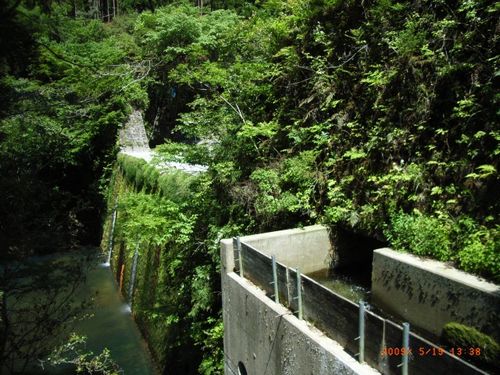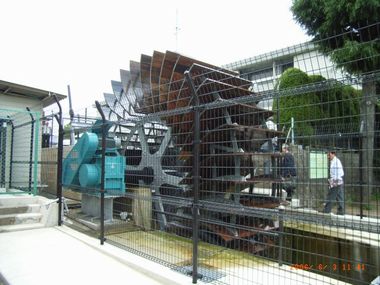August 17, 2010
Small Hydropower Brings Possibility of Locally Generated Electricity for Local Consumption
Keywords: Newsletter
JFS Newsletter No.95 (July 2010)

Copyright Japanese Association for Water Energy Recovery
As of 2008, there were a total of 4,861 hydro, thermal, and nuclear power stations in Japan, with a combined maximum generation capacity of 277.51 million kilowatts (kW) of electricity.
Japan currently imports 96 percent of its primary energy in the form of petroleum, natural gas, coal, and uranium. These primary energy sources become the raw materials for hydro, thermal, and nuclear power generation. Japan's current domestic energy sufficiency rate is a mere 4 percent if nuclear power is not included.
In light of this situation, Japan is striving to shift toward renewable energies such as wind, photovoltaic (PV), hydro, and geothermal, which are energy sources that lessen dependency on primary energy resources and reduce carbon dioxide (CO2) emissions.
As a source of renewable energy, hydropower has a history of over 100 years, and has played a key role in Japan's modernization and economic development as truly domestically produced energy. The most economically viable sites for hydropower generation in Japan, however, have already been completely developed. In addition, large hydropower development grows increasingly difficult these days, as people become more aware that large-scale development leads to issues such as environmental destruction and the loss of history and culture.
Therefore, people are having a new look at small hydropower as a source of renewable energy. Small hydropower has supplied electricity at the local level for many years, utilizes local water resources, and does not require the construction of large-scale dams or other major development projects. In this article we will introduce the developments and possibilities of small hydropower, an old but reemerging energy source.
What is Small Hydropower?
Hydropower refers to a system in which electricity is generated by utilizing the vertical gradient over which water flows and its water volume to spin a turbine. Worldwide, small hydropower is classified as an installation capable of producing 10,000 kW or less. In Japan, the electrical power industry and the New Energy Development Organization guidelines agree with this classification.
For small to medium hydropower development projects subsidized by the Japanese Ministry of Economy, Trade and Industry, small to medium hydropower is defined as having a generation capacity of 30,000 kW or less. Meanwhile, both the Law Concerning Promotion of the Use of New Energy and the Renewables Portfolio Standard Law (Special Measures Law Concerning the Use of New Energy by Electric Utilities) define small hydropower as 1,000 kW or less.
Small hydropower refers not to the damming, storing and control of river water, but rather to the harnessing of energy from flowing water wherever it may be, whether is in a free-flowing river, an agricultural canal, a public water supply, a dam built for landslide prevention, or whatever. Rather than defining small hydropower by its generating capacity, the International Energy Agency's Hydropower Implementing Agreement defines small hydropower to be environment-friendly hydropower that does not involve large dams or other large-scale developments.
Advantages of small hydropower compared to other renewable energies include the ability to operate year-round and both day and night, the high utilization rate of total capacity (five to eight times as much as PV power generation), little fluctuation in generation capacity, as well as good economic potential and a large amount of technically and economically feasible hydropower energy. On the other hand, disadvantages include being limited to accessible sites that have sufficient elevation change and good water flow, fluctuation in power generation caused by changes in flow volume during wet and dry seasons, issues of stakeholders' interests concerning water use such as water rights, and complicated legal procedures.
The Potential of Small Hydropower
Five times between 1910 and 1986, the Japanese government conducted a nationwide survey (Hydroelectric Power Generation Potential Survey) on rivers to test their suitability as hydropower sites. Surveying brought an understanding of which sites were promising for potential development, and dam development proceeded at those sites. The potential hydropower surveyed refers to the technically and economically feasible hydropower energy identified in the survey as a portion of Japan's total water resources. This potential hydropower is then further divided into three categories: developed, under construction, and undeveloped (promising resources for future development).
According to the fifth Hydroelectric Power Generation Potential Survey, conducted by the Agency for Natural Resources and Energy, the total generation capacity of technically and economically feasible hydropower energy is approximately 32.75 million kW, and the total possible annual power generation is 134.2 billion kilowatt-hours (kWh). Examination of small hydropower of less than 1,000 kW reveals a total of 853 technically and economically feasible hydropower energy sites, with 450,000 kW of potential capacity. Of these, 371 sites with a combined capacity of 240,000 kW are undeveloped.
5th Hydroelectric Power Generation Potential Survey (Section 9 & Table 8)
http://www.nef.or.jp/english/new/present.html
The Japanese Ministry of the Environment conducted the "Study of Potential for the Introduction of Renewable Energy" in fiscal 2009. In the study, energy resources that can be estimated theoretically but do not take into account various limiting factors (such as land application or application technology) are defined as "potential." Using water channel alignment data from the Geospatial Information Authority of Japan, and other data including national and prefectural catchment flow quantity data, the ministry estimated the potential for small to medium hydropower. Data indicated that nationwide, there are 22,474 potential small hydropower sites of 1,000 kW or less, with a combined total capacity of 6.29 million kW. These figures clearly differ significantly from the results of the fifth Hydroelectric Power Generation Potential Survey.
Study of Potential for the introduction of Renewable Energy
http://www.env.go.jp/earth/report/h22-02/full.pdf
(only in Japanese except for English Summary, S15-S31)
Masaru Nakajima, Secretary General of the Japanese Association for Water Energy Recovery, believes that, based on the above estimates and giving consideration to economic potential, Japan's small hydropower potential is approximately five million kW, which he explains is "enough to satisfy 3 percent of Japan's total annual electricity consumption."
Japanese Association for Water Energy Recovery
http://j-water.jp/
(only in Japanese)
Future Issues for Small Hydropower
Enthusiastic development of small hydropower in the future would help lessen dependency on petroleum, improve energy sufficiency, and contribute to the prevention of global warming, but there are many problems that still require solutions.
Nakajima explains, "Problems with water rights and over-complicated legal procedures exist, but the biggest issue at hand right now is: 'What type of leadership system do we build in order to produce electricity locally for community use?' That's the question." In the past, communities handled the maintenance and management of small hydropower stations locally. To return this responsibility to local communities, it is necessary to model efforts after a structure in which projects are led not by electric companies, but by local governments, Land Improvement Districts, non-profit organizations, businesses, and individuals.
One small hydropower station was reborn on the grounds of the city hall in Tsuru, Yamanashi Prefecture, in October 2005. In the past, a small hydropower station had provided electricity to the area, but changes in the times called for its operation to be discontinued. The Tsuru example is just one case where a new purpose was granted to a revitalized power station.

Genki-kun #1
Copyright Japanese Association for Water Energy Recovery
The revitalized Kachugawa Small Hydropower Station was built in Tsuru thanks, in part, to citizen investment. Tsuru issued 17 million yen (about U.S.$191,000) worth of "mini public bonds," and subsequently received about four times the necessary responses from potential investors. The new power station is called Genki-kun #1 ("energetic boy" in Japanese), and the electricity it generates is used in the city hall building. Genki-kun #1 has a maximum generation capacity of 20 kW, and a regular capacity of 8.9 kW. In Tsuru, people think of small hydropower as a key element of community-building. Tsuru and its citizens intend to continue efforts to conserve energy and prevent global warming in the future.
Efforts to promote small hydropower are beginning to appear throughout Japan. In the future, we at JFS intend to continue highlighting these efforts to promote local production and local consumption of energy through utilization of renewable energy in which citizens play an active part.
Written by Kazumi Yagi
See also:
Toyama Prefecture to Construct Micro-Hydropower Plant on an Irrigation Canal
http://www.japanfs.org/en/pages/027034.html
MOE Announces New Funding for Community-based Environmental Protection Projects
http://www.japanfs.org/en/pages/026989.html
Green Power Satisfies Household Electricity Demand in 76 Japanese Municipalities
http://www.japanfs.org/en/pages/026849.html
Related
"JFS Newsletter"
- 'Good Companies in Japan' (Article No.4): 'Eightfold Satisfaction' Management for Everyone's Happiness
- "Nai-Mono-Wa-Nai": Ama Town's Concept of Sufficiency and Message to the World
- 'Yumekaze' Wind Turbine Project Connects Metro Consumers and Regional Producers: Seikatsu Club Consumers' Co-operative
- Shaping Japan's Energy toward 2050 Participating in the Round Table for Studying Energy Situations
- 'Good Companies in Japan' (Article No.3): Seeking Ways to Develop Societal Contribution along with Core Businesses


